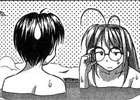Love Hina by Djudge
| Also Known As: LH | ||
| Genre: Romance/Comedy | ||
| Length: 14 Volumes | ||
| Allegiance: TokyoPop | ||
| Mangaka: Akamatsu Ken | ||
| Vintage: 1999-2002 | ||
| Intelligence Agency Report by: Djudge | ||
| Urashima Keitaro is your typical twenty-something loser. Poor, no girlfriend, and striving to make it out on his own. The only thing keeping him going is a promise to get into the prestigious Tokyo University he made in his childhood with a girl whose name he can’t even remember. After failing the entrance exams to the school several times, Keitaro is given a reprieve by his grandmother who places him in charge of a hot spring inn. However, upon arriving at the given address, Keitaro finds that the inn is now all-girl’s dormitory and he’s now its manager! Will he ever be able to get into Tokyo University at this rate? | ||
|
|
||
| Research Agent Report by: Djudge | ||
| Plot Characters Impact Visual |
9.00 9.25 9.00 9.50 |
|
| Overall | 9.25 | |
| (not an average) | ||
| Even though I’ve moved onto other manga titles, Akamatsu Ken’s Love Hina easily remains as one of my all-time favorites. The characters found in the pages of this piece can initially be passed off as mere shells created off stock shounen comedy templates, but as the reader progresses through the story they can easily find that each character has deeper layers than one can initially see. It is perhaps this attraction to the personalities that the mangaka creates that draws me the most to Love Hina. Couple that with tons of hilarious sequences and you have a read that no manga otaku should pass up for any reason.
The manga itself looks great, even though Akamatsu starts strong in overall visual presentation, the detail that he puts into each character’s expression makes each panel on the page just that much more effective. In later volumes, the manga becomes even more vivid when more dramatic scenes are drawn. Precise angling and up-close shots are hallmarks of the shounen comedy genre and in Love Hina, they are used to great effect for not only the obligatory fan service, but also for conveying the emotions and body language of each of the characters. In terms of overall look and feel, the title excels at nearly every facet. Plotwise, Love Hina suffers just a little due to the fact that many projects in the same genre have used more-or-less the same build for each of the characters in the story. However, several volumes into the story, it can be seen that each of the girls at the dormitory are more than side-characters as they are given time to develop both their personalities and their relationship with the main character. It can probably be said that very few characters introduced over the course of the manga had little or no impact on the story. In this way, Akamatsu manages to keep a large and great cast of versatile characters that could be reused again and again in a variety of different scenarios. The last important aspect of Love Hina’s plot is its conclusion. Although the story managed to move quite smoothly for first two-thirds or so of the manga, by the time we see Keitaro actually seriously court one of his female co-stars, the plot’s fluidity is sacrificed for the sake of satisfying a drawn-out cliffhanger type sequence in which the reader can finally rest assured about how Keitaro’s search for love will end. This particular succession of events in my opinion could have used some condensation, but in the end it is after all the mangaka that decides how his/her work will flow. All in all, Love Hina is nothing new for fans of romance/comedy manga. However, this particular work offers a great look in how the genre works and offers a prime opportunity to try and get hooked onto similar titles.
|
||




